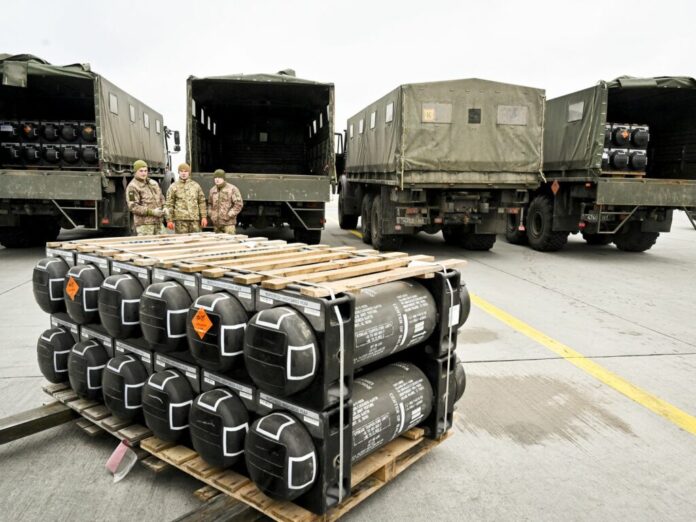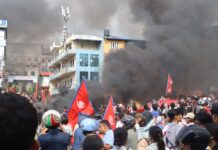One year on, not only is the war far from over, it is clearly escalating with the possibility of becoming a much wider conflict.
Tom Crean, ISA International Executive
(This article was first published on 23 February 2023)
The horrific war in Ukraine, which began nearly a year ago, is by far the biggest on the European landmass since World War II. Total casualties, both dead and wounded, number in the hundreds of thousands. City after city in Eastern and Southern Ukraine have been reduced to rubble. The effects for the civilian population have been devastating. Of the pre-war population of 40 million, 8 million have fled Ukraine while 5.9 million more are internally displaced. The World Food Program estimates that one in three households in the country is food insecure, in one of the breadbaskets of the world.
International Socialist Alternative opposed Russian imperialism’s brutal invasion from the start and Putin’s attempt to deny Ukraine’s right to even exist as a nation. From the beginning, this war has been a battleground for the inter imperialist conflicts which increasingly dominate our epoch, most immediately between Russian imperialism and NATO, itself a “sub plot” in the wider Cold War conflict between U.S. and Chinese imperialism. Not only is the war far from over, it is clearly escalating with the possibility of becoming a much wider conflict.
The phases of the War
The war in Ukraine has gone through several phases. In the initial phase, the Russian army sought to invade from several directions, make a lightning strike, seize Kyiv and depose the Ukrainian government. This was a complete failure. In the wake of this, Russian forces sought, with some success, to consolidate their position in Eastern and Southern Ukraine, using brutal siege tactics.
However, the tide turned when the Ukrainian military began a large-scale counter offensives in August, exposing weaknesses in the Russian front. They took control of the Kharkiv region in the Northeast and continued making gains until the Russian army pulled out of Kherson in the South in November.
Since then neither side has made a major breakthrough. The Russian military has dug into positions in Eastern Ukraine using freshly mobilized troops. The Russian military has also launched relentless drone and rocket attacks with the aim of degrading Ukraine’s infrastructure and leaving the Ukrainian people freezing in the dark through the winter.
The battle for Bakhmut in the Donetsk region in Eastern Ukraine is being compared to battles in World War I and has come to symbolize the current stage of the conflict, a vicious war of attrition dubbed “the meat grinder”. The Russian military, led in the battle for a period by the mercenary Wagner group, has nevertheless made some advances at huge cost in lost lives and may soon control the city.
The Zelensky regime and its Western imperialist backers are increasingly concerned, however, that a coming Russian offensive using the 300,000 newly conscripted soldiers could make more significant gains or at least significantly complicate another Ukrainian counter-offensive. If the Putin regime is able to hold on to the territory it occupies in Eastern Ukraine as well as Crimea, a new Ukrainian offensive will not be the decisive blow to the Russian military that is intended by the U.S. They want Russian forces to be put clearly on the defensive and losing more ground with even their control of Crimea (occupied in 2014) threatened before entering negotiations.
It is absolutely undeniable that Ukrainian soldiers, who are motivated to defend their homes and towns and have the enthusiastic support of the big majority of the population, have displayed enormous determination and this has been a central factor in pushing back the Russian military juggernaut. But as the Institute for the Study of War and many others have pointed out, “The pattern of delivery of Western aid has powerfully shaped the pattern of this conflict.” This stretches from the Javelin anti-tank missile that helped Ukraine defeat the Russian forces’ drive on Kyiv; to the large amounts of Soviet-era weapons systems and munitions sent by Eastern European members of NATO; to the delivery of more advanced Western systems including the HIMARS that facilitated the Ukrainian counter-offensive. From another point of view, the increasing coordination with Western imperialism pushed back any elements of working class resistance from below, as when nuclear power plant workers and residents came out to confront Russian troops early in the war in Zaporizhzhia.
In general there has been a shift from sending weapons that could be presented as “defensive” to weapons that are undeniably “offensive” — from Javelins to Bradley fighting vehicles and now tanks. At the start of the war, the Biden administration presented itself as being very concerned about a direct conflict between Russia and NATO. But it has been steadily going over its own “red lines.” At a recent conference led by U.S. defense secretary Lloyd Austin, representatives from 50 governments discussed arm delivery plans.
The escalatory spiral
The U.S. has been prepared to take previously unthinkable steps in the course of this war. Longstanding American investigative journalist Seymour Hersh has very convincingly argued that U.S. Navy divers working with the CIA and the Norwegian military planted the explosives that were subsequently detonated to blow up the Nordstream 2 pipeline under the Baltic Sea which was intended to supply natural gas from Russia to Germany as part of a major pre-war agreement. If Nordstream 2 had become fully operational, it would have provided for 50% of Germany’s annual consumption of natural gas.
In the wake of the attack, U.S. Secretary of State Blinken declared, “It’s a tremendous opportunity to once and for all remove the dependence on Russian energy and thus to take away from Vladimir Putin the weaponization of energy as a means of advancing his imperial designs.” So whether or not the U.S. did it directly, they certainly approve of it and almost certainly were involved, despite all the denials.
As the war enters a new phase, Western, and especially U.S., imperialism has decided it needs to go further. Hence the drama that played out for weeks at the start of 2023 about sending battle tanks to the Ukrainian military. Pressure was put on the German government to agree to authorize German-manufactured Leopard tanks (widely used by European armies) to be sent to Ukraine. The German chancellor Olaf Scholz would not agree, however, until the U.S. also agreed to send Abrams tanks thus providing German imperialism with political cover.
A whole series of countries from Poland to the UK and the U.S. have now pledged to send hundreds of tanks to Ukraine on a timescale ranging from a couple months to a year or more. But even before the tanks were promised, the U.S. committed to equipping the equivalent of two armored battalions with Bradley and Stryker armored vehicles.
However, on the very next day after the Germans agreed to send tanks and to allow other countries to send Leopards, an immediate hue and cry went up in the Western media: tanks will not be enough! It’s time to send fighter jets! And while the most advanced Western planes are apparently still off limits, Slovakia has already pledged to send Soviet-made jets. If the tide of battle turns against Ukrainian forces, we can expect this and other red lines to be crossed as well.
The Kiel Institute reports that the total aid of all types committed (not delivered) by the West from January 24, 2022 through January 15, 2023 totalled over 140 billion euros. The U.S. alone has committed 44.3 billion euros ($47.2 billion).
The question of Crimea
But the question of escalation is not just about weapons systems. On January 19, the New York Times reported that the Biden administration — which had previously opposed the Zelensky regime’s threat to launch an offensive on the Crimean peninsula — had changed its mind.
On the one hand, the U.S. is considering supporting the Ukrainian military in trying to cut the land bridge from Russia to Crimea, seized during the 2022 invasion, which is vital to supplying the Russian military in Southern Ukraine. But they are also moving towards the conclusion that unless the Putin regime feels there is at least a real threat to its control of Crimea itself, it will not be possible to force the necessary concessions at the negotiating table.
This would in itself represent a significant escalation, attacking a region that has been part of the Russian state since 2014 and a large part of whose population seems to have accepted this. We stand for the right of people in Crimea and other minority communities in Ukraine, including Russian speaking areas, to determine their own future, just as the Ukrainian people have the right to do, free from interference and not at the point of a gun.
The New York Times reassuringly goes on to say that “fears that the Kremlin would retaliate using a tactical nuclear weapon have dimmed” but then admit that “For their part, U.S. officials say they do not know how Mr. Putin will react if Ukraine attacks Crimea using American-supplied weapons.”
To be clear, the Ukrainian military is not yet in a position to launch such an offensive but even the fact that the Biden administration is seriously considering this speaks to the escalatory spiral of this conflict. It continues to slide towards becoming a direct fight between NATO and Russia and not just a proxy war.
The character of the War
The Ukraine war cannot be understood outside of the context of the new era of global instability where inter-imperialist rivalry and conflict is posed in a far sharper way than during the previous era of neoliberal globalization. The inter-imperialist character of the conflict is not its only feature, because it also has the element of a fight against foreign occupation by an invaded people, as well as other features. But to put it bluntly, the motivation, suffering and struggle of the Ukrainian people has, in agreement with Zelensky, been “hijacked” by Western imperialism for its own ends.
The Russian regime has increasingly sought to break out of NATO encroachment and assert itself both in its own “backyard” and beyond as it has done in Syria and now in sub-Saharan Africa. Putin and China’s Xi Xingping signed a “no limits” partnership right before the war that emboldened Putin. The Putin regime also saw the humiliating exit of American forces from Kabul in 2021 as indicating that the U.S. and Western imperialism would be unable to effectively counteract a swift and successful invasion.
However, the invasion of Ukraine was a profound blunder by Putin’s regime; they massively overestimated their own military capacity. They massively underestimated the determination of the Ukrainian people to resist, the military training of the Ukrainian army since 2014 and also Western imperialism’s determination to not accept a Russian victory which would represent a significant blow to their interests and prestige.
The U.S. in particular has seized the war as an opportunity to reassert itself globally and to strengthen NATO and their broader Cold War bloc not just against Russia but against China. While it escalates militarily in Ukraine, U.S. imperialism is also waging economic war against China, seeking to cut off its access to high end semiconductor technology and thereby block its development in high tech. The Biden administration seeks to inflict a defeat on Russia in no small part to send a very clear message to Xi Jinping about Taiwan. The U.S. is now also directly warning China against sending military aid to Russia saying this would be a “serious problem” for rapidly deteriorating U.S./China relations.
“Aid” on the scale being sent by Western imperialism to the Ukrainian state inevitably comes with conditions. There are no imperialist arms without an imperialist agenda. When this war comes to an end, Ukraine will be completely in hoc to Western interests. They will take control of the country’s resources and they will make Ukraine a permanent armed forward camp for Western imperialism.
Increasingly the U.S. is calling the shots as Ukraine becomes ever more dependent on Western powers for military hardware and finance. But as former Israeli prime minister Naftali Bennett has recently revealed, even in the early days of the war, the U.S. intervened to block his attempt to negotiate a cease-fire between Ukraine and Russia.
There are those on the left, such as the Left parties in Sweden and Finland or the Squad in the U.S. Congress, who argue that we should unequivocally take the side of the Ukrainian bourgeois state in its fight with Russian imperialism and support its arming by Western imperialism. They argue that this is essentially a war of national liberation and ignore or downplay the role of Western imperialism.
Such a position represents a capitulation to U.S. imperialism which remains, despite its indisputable weakening, the dominant imperialist power in the world, and an enemy of the oppressed and working class everywhere. It would be to accept the narrative of Joe Biden that this is a fight of “democracy against autocracy.”
These leftists paint the reactionary Zelensky regime in rosy colors, ignoring its massive program of privatizations and anti-union legislation that has eliminated the rights of 70% of workers (in firms with less than 250 employees) to enter into collective bargaining with their employers. Among other consequences, workers fired for union activity in these companies have no legal protection.
The logic of supporting the Ukrainian state also points to supporting the U.S. escalating its arming of Taiwan to defend it against a threatened invasion by Chinese imperialism. Ultimately it would mean actively supporting U.S., Japanese and other imperialisms if a war over Taiwan broke out, in the name of supporting the people of Taiwan. Such a war to be clear is a very real possibility in the coming years.
Divisions in the Western camp
In general, the camp of Western imperialism, led by the U.S., has acted in a more united way than even most capitalist commentators expected. However, the divisions in the Western camp are certainly real. There are different views on the desired outcome of the war in Ukraine but also on how far to go in the wider conflict with China. The interests of German and French imperialism, for example, do overlap with those of U.S. imperialism but they are also distinct.
In the course of the last year, Eastern European countries like Poland and the Baltic States as well as the UK have had a far more bellicose position on the Ukraine war, backing up the U.S., while there was hesitation from France and Germany. But in the new year, the key European powers and the U.S. have been actually moving closer together, not further apart. This of course could change again.
In part, Germany and France have been emboldened as the projected energy crunch did not materialize (at least for now) in Europe in the way that was predicted due to a mild winter. European total aid of all sorts committed to the Ukrainian state now totals almost 55 billion euros.
And while we see an increasingly assertive German and French militarism, half a world away, Japanese militarism is also on the rise as part of the developing anti-China military alliance in the Pacific. All of these powers are committing to rapid expansion of their militaries. This shows how the Ukraine war is part of a broader global process of growing inter-imperialist conflict, with the attendant whipping up of nationalism, growing militarism and protectionism.
What comes next
There is no immediate prospect of the war to come to an end. Neither side is ready to negotiate. This points to the war dragging on for months if not years with the danger and even likelihood of further escalation. There have of course been many threats by the Putin regime to use nuclear weapons. This remains unlikely for a number of reasons. However, as the past year has amply demonstrated, war, even involving nuclear powers, can escalate massively even while being restricted to the use of “conventional” weapons. The main danger is that the war becomes an ever more direct conflict between NATO and Russia and that it spreads geographically.
But the consequences of the continued war go much further. These include the disastrous effect on global food and fertilizer supplies caused by the war including the threat of mass starvation in parts of the world. This has already begun in the Horn of Africa. Another year or more of war will also have significant negative consequences for the fragile world economy despite the recent more upbeat projections by the IMF.
A defeat for Russia remains the most likely outcome of the war although clearly there is concern in the Zelensky regime and NATO that the Russian military has “not said its last word.” Russia has far more soldiers and a population nearly four times the size of Ukraine. Its economy has managed to counteract severe sanctions with huge revenue from oil and gas and its munitions factories are operating on triple shifts. Latest reports indicate that Russia may be preparing to use its still largely intact and potent air force on a wider scale in Ukraine. The concern of the Zelensky regime is reflected in the urgency to get more offensive weapons from the West.
Military defeat for Russia would almost certainly produce a massive political crisis and possibly lead to the removal of Putin, though in the short term, given the weakness of the Russian left and labor movement, this may lead to an even more dangerous military dictatorship led by nationalist hardliners, not a social revolution. But the horrific conditions within the Russian military and the decreasing enthusiasm for the war could also lead to a mass revolt within the armed forces, a situation akin to what happened to the U.S. military in Vietnam.
On the other hand, recent reports point to problems with morale in the Ukrainian army due to the conduct of the war by the regime. This has been acknowledged by Zelensky himself. Other reports indicate that there have been significant desertions of soldiers who understandably don’t want to be thrown into the “meat grinder” of Bakhmut. There are also signs of increasing tensions within the Ukrainian regime, with rolling corruption crises and cabinet dismissals.
If or when Zelensky signs a treaty that falls short of restoring 100% of “Ukrainian territory” there will be a fierce reaction from sections of the population who have accepted the scale of casualties and destruction in order to achieve this goal. Who is likely to lead such a struggle? At this point it would likely be the far right in Ukraine which would benefit in this situation. But given the vicious attacks on working people by the Zelensky regime there is also the potential for the reemergence of the class struggle.
What is the way forward?
The course of the war completely confirms that there is no basis for genuine independence for Ukraine on the basis of capitalism. This will require a revolutionary struggle led by the Ukrainian working class against all imperialist forces linked to a workers movement internationally conscious of its tasks.
The key missing factor in Ukraine today is an independent working class force. One question that arises is how such a force, if it were leading the struggle against Russian occupation, would arm itself since the West would certainly not be arming it. A working class led struggle would not just be military but more fundamentally political in character. It would mean the mass mobilization of the population, the formation of workers councils in workplaces and communities to organize the struggle. Ukraine today is awash in weapons and the working class would find a way to seize weapons.
But more importantly, a working class force in Ukraine could potentially have enormous success in launching a direct class appeal to Russian soldiers, hundreds of thousands of whom are conscripts who don’t want to be there! Our goal is to end the slaughter and to wage a common struggle against the real enemies of the people, the oligarchs in Kyiv and Moscow and imperialism in general.
Today, the warmongers are in the driver’s seat. But this can and will change. In Russia, the left and liberal opposition that came on the streets to oppose the invasion of Ukraine a year ago faces intense repression. But while protest has been suppressed, the massive casualties and forced conscription have created enormous anger and resentment in wide sections of the population far beyond the metropolitan centers of Moscow and St. Petersburg.
In many NATO countries there has also been intense political pressure to toe the line of Western imperialism. There has been relentless propaganda in Sweden and Finland to join NATO. In Germany there has been intense propaganda to support resurgent German militarism. The same is of course true in the U.S. and the UK. However, polls show declining support for further escalation and increasing questioning of the costs of the war. In the U.S., because of the complete failure of the “left” in Congress, including the so-called Squad, to put forward an independent position, it is the hard right that makes an “antiwar” case but on a purely nationalist basis.
In parts of Africa, on the other hand, and not just there, the left and even sections of the establishment support Russia and China as the “enemy of my enemy.”
War poses a unique test for the left and revolutionary left. The bulk of the left, including the far left, has utterly failed this test. The reformist left in the West has lined up behind Western imperialism while many on the “far left” have been apologists for Russian imperialism, as the “lesser evil” or even allegedly “non-imperialist” power. Our position is based on the tradition of consistent anti-militarist, anti-imperialist internationalism embodied by the great Marxists Liebknecht, Luxemburg, Lenin and Trotsky during World War I. The task facing the labor movement today and especially its most conscious elements is to build a mass movement of workers and youth against the war, against all measures of escalation and against both imperialist camps.




